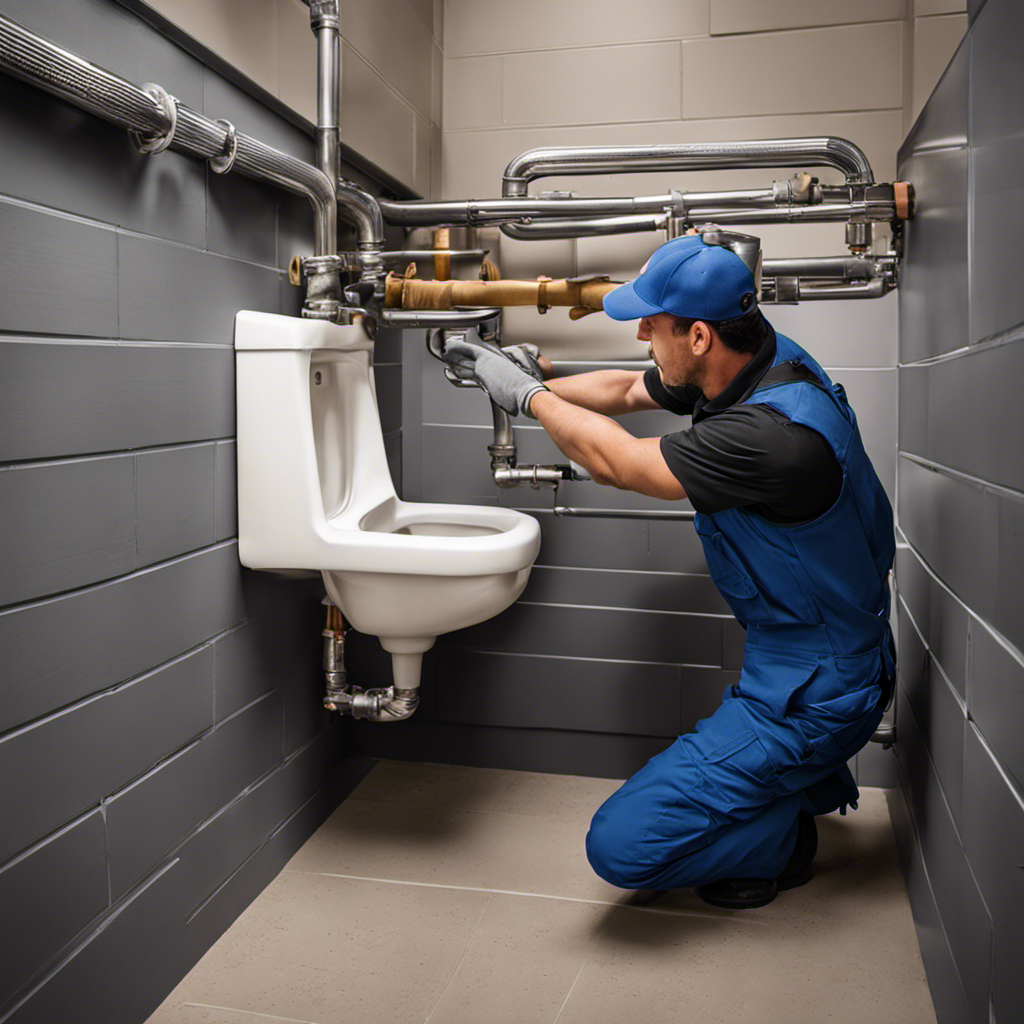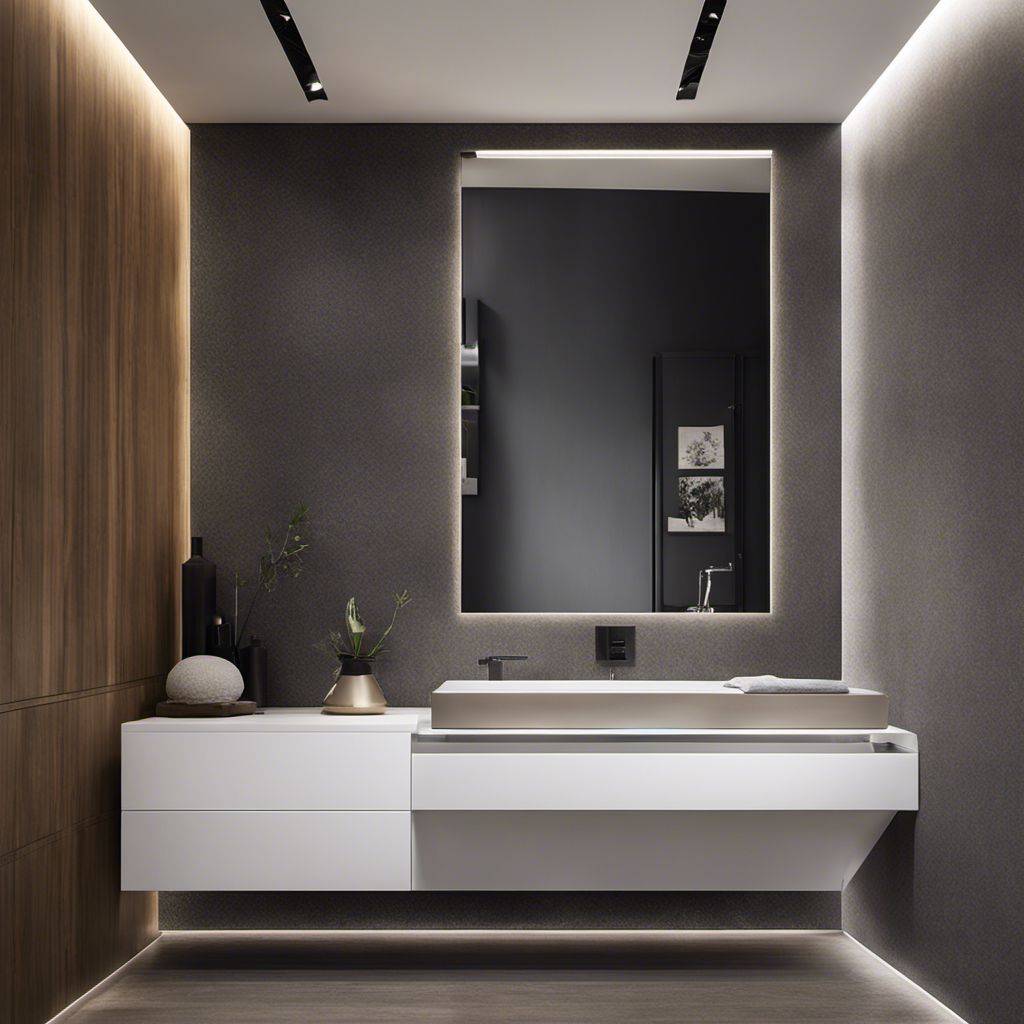Looking to install a urinal but not sure where to start? Look no further than ‘The Ultimate Guide to Urinal Installation.’
This comprehensive guide provides step-by-step instructions on hanging a urinal, including gathering tools, fitting a mounting board, adding a water line, and installing the drain.
Curious about the different types of urinals and urinal systems? This guide covers it all, from trough urinals to water-free systems.
Get ready to tackle your urinal installation project with confidence and expertise.
Key Takeaways
- There are different types of urinals available, including trough urinals, corner urinals, bucket urinals, sensor urinals, and stall urinals.
- Urinal systems can be manual, automatic, timed, water-free, or use biological blocks, liquid sealant, or membrane traps for odor and blockage prevention.
- The installation process for hanging a urinal involves gathering essential tools, fitting a mounting board, adding a water line, attaching urinal wall hangers, and installing a drain.
- Water-free urinals are a popular option as they save water, eliminate the need for blockage removals and repairs, and are considered hygienic.
Types of Urinals
The guide explains the different types of urinals, including trough, corner, bucket, sensor, and stall urinals. Each type has its own advantages and benefits.
Trough urinals, made of stainless steel or porcelain, can accommodate multiple individuals at once and are easy to install.
Corner urinals are designed to fit in the corner of a wall, making them a space-saving option for small bathrooms or toilets.
Bucket urinals, made of various materials like wood, metal, or plastic, have a versatile design with a separate drainage system.
Sensor urinals, on the other hand, are popular and modern. They have an automatic water flushing system with sensors, making them clean, hygienic, and water-efficient.
Overall, the different types of urinals offer various materials and functionalities to suit different needs and preferences.
Types of Urinal Systems
Flush systems for urinals offer manual, timed, and automatic options to suit different preferences and needs.
Among these options, sensor urinals have gained popularity for their numerous benefits. Sensor urinals feature an automatic water flushing system that is activated by sensors, ensuring a clean and hygienic experience. One of the key advantages of sensor urinals is their water-saving capability. Compared to other urinals, sensor urinals use less water, contributing to water conservation efforts.
Additionally, sensor urinals eliminate the need for manual flushing, promoting a touchless experience and reducing the risk of germ transmission.
When it comes to material comparison, urinals are commonly made of stainless steel or porcelain. Stainless steel urinals offer durability and resistance to corrosion, while porcelain urinals provide a classic and aesthetic appeal. The choice of material ultimately depends on the desired look and functionality of the urinal.
Installation Process
Using essential tools like a tape measure and electric drill, one can easily hang a urinal by following the installation process. Here are some common mistakes to avoid during urinal installation:
-
Incorrect measurement: Accurate measurement is crucial to ensure proper positioning and height of the urinal. Using a tape measure, one should measure the desired height from the floor to the rim of the urinal, which is typically 24 inches for wall-mounted urinals.
-
Inadequate support: A mounting board should be securely fitted to the wall to provide support for the urinal. Failure to properly secure the mounting board can result in instability and potential damage.
-
Improper sealing: The drain of the urinal should be tightly sealed with caulk to prevent leaks. Neglecting to seal the drain properly can lead to water damage and unpleasant odors.
-
Poor alignment: It is important to ensure that the urinal is level and aligned correctly with the wall hangers. This will prevent any issues with stability and maintain the aesthetic appeal of the installation.
How High to Mount a Urinal
To ensure proper installation, one should measure the desired height from the floor to the rim of a wall-mounted urinal, typically 24 inches. This height is considered standard for wall-mounted urinals, providing optimal comfort and convenience for users.
However, it’s important to note that urinal height regulations may vary depending on local codes and regulations, so it’s crucial to check before installation.
Wall-mounted urinals offer several benefits, including space-saving, easy maintenance, and improved hygiene. These urinals are commonly used in commercial settings such as public restrooms, restaurants, and office buildings.
Water-Free Urinals
Water-free urinals have become increasingly popular due to their ability to save water, eliminate plumbing systems, and prevent the growth of bacteria and mold. These urinals offer several advantages over traditional flush urinals:
-
Water conservation: Water-free urinals completely eliminate the need for water, saving thousands of gallons of water per year.
-
Cost savings: By eliminating the need for water, water-free urinals reduce water bills and maintenance costs associated with plumbing systems.
-
Hygiene benefits: Water-free urinals prevent the growth of bacteria and mold, ensuring a clean and odor-free environment.
-
Easy maintenance: Water-free urinals require minimal maintenance compared to traditional urinals. Regular cleaning and periodic replacement of liquid sealant cartridges or membrane traps are necessary to maintain optimal performance.
To ensure the longevity and efficiency of water-free urinals, it is important to follow these maintenance tips:
-
Regular cleaning: Clean the urinal regularly using mild detergent or specialized urinal cleaner to remove any buildup or residue.
-
Cartridge or trap replacement: Replace liquid sealant cartridges or membrane traps as recommended by the manufacturer to ensure optimal performance.
-
Inspection: Regularly inspect the urinal and its components for any signs of damage or leaks. Address any issues promptly to prevent further damage.
-
Educate users: Provide proper instructions to users on how to use the water-free urinals correctly to prevent misuse or damage.
Frequently Asked Questions
Are There Any Specific Regulations or Codes That Need to Be Followed When Installing a Urinal?
Yes, there are specific regulations and codes that need to be followed when installing a urinal. Proper urinal installation is important to ensure compliance with building codes and to maintain functionality and hygiene.
What Is the Average Cost of Installing a Urinal, Including Both Materials and Labor?
The average cost of installing a urinal, including both materials and labor, can vary depending on factors such as the type of urinal and the complexity of the installation process.
Can a Urinal Be Installed in a Residential Bathroom, or Are They Only Suitable for Commercial or Public Spaces?
Installing a urinal in a residential bathroom offers benefits like water conservation and convenience. However, homeowners may face challenges such as meeting plumbing requirements, space limitations, and potential resistance from family members.
Is It Possible to Convert a Traditional Urinal Into a Water-Free Urinal?
Yes, it is possible to convert a traditional urinal into a water-free urinal. By installing liquid sealant cartridges or membrane traps, one can enjoy the benefits of water-free urinals, such as water conservation and reduced maintenance. Regular cleaning and proper maintenance are essential to ensure optimal performance.
Are There Any Specific Maintenance Requirements for Water-Free Urinals, and How Often Do They Need to Be Serviced?
Water-free urinal maintenance includes regular cleaning and sanitizing of faucets, pipes, and fittings. Cartridges and membrane traps should be replaced periodically. Benefits of water-free urinals include water and cost savings, reduced maintenance, and improved hygiene.
Conclusion
In conclusion, the ultimate guide to urinal installation provides a comprehensive overview of the different types of urinals, urinal systems, and the installation process.
From trough urinals to sensor urinals, and flush systems to water-free urinals, this guide covers it all.
The step-by-step instructions for hanging a urinal, along with the recommended height for mounting, ensure a precise installation.
And let’s not forget the benefits of water-free urinals, which not only save water and money but also promote hygiene and cleanliness.
So, whether you’re a seasoned professional or a DIY enthusiast, this guide is your go-to resource for a successful urinal installation.
Don’t miss out on this must-have anachronism that will keep you engaged and informed throughout!










